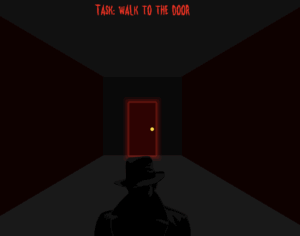Concept
An Unusual Case is a horror mystery game, inspired by escape rooms, where there are scattered clues around the game in each room, and the user will have to identify them to move on to the next room and solve the mystery. Else, they are forever trapped in the room. The concept aims for the user to both have an engaging and entertaining experience while thinking through the clues and pushing them to think outside the box. Focusing on the player’s problem-solving and creative skills. Clues never give away the answer directly, rather they push the player to apply critical thinking and pattern recognition.
To make the game even more engaging, the themes of the game visual design are darkness and the melancholy which tie in well with the color palette consisting of deep shadows and muted tones. The mood is further curated by the sound effects that go from very quiet background noises to loud and sudden jumpscares, a mix that is intentional to keep players on edge and engaged. This horror aspect is not just for the sake of enticing fear but also to pull the players into the emotional tension of the situation, thus making every choice and revelation feel more powerful. In the end, An Unusual Case has the ambition to be a combination of mental challenge, appealing story, and spooky atmosphere, giving players a very deep and engaging experience.
Code Snippet
draw() {
// Perspective scaling for hallway
let scaleFactor = 200 / wallDist;
let w = wallSize * scaleFactor;
let h = wallSize * scaleFactor;
let cx = width / 2;
let cy = height / 2;
let left = cx - w / 2, right = cx + w / 2, top = cy - h / 2, bottom = cy + h / 2;
// Draw hallway walls
fill(20, 0, 0); noStroke();
quad(0, 0, left, top, left, bottom, 0, height);
quad(width, 0, right, top, right, bottom, width, height);
// Fog effect
this.fogAlpha = 40 + 20 * sin(millis() * 0.005);
fill(0, 0, 0, this.fogAlpha);
rect(width / 2, height / 2, width, height);
// Door setup and glow animation
let doorWfull = w / 3, doorH = h / 1.5;
let doorX = cx, doorY = bottom - doorH / 2;
doorBounds = { x: doorX, y: doorY, w: doorWfull, h: doorH };
if (!doorOpen) {
let elapsed = millis() - this.lastGlow;
if (elapsed < 3000) this.glowAlpha = 60 + 40 * sin((elapsed / 3000) * TWO_PI);
for (let i = 1; i <= 3; i++) {
fill(255, 0, 0, this.glowAlpha / (i * 1.5));
rect(doorX, doorY, doorWfull + i * 12, doorH + i * 12, 8);
}
}
// Door animation and jumpscare trigger
if (doorAnim > 0.01 && !this.jumpscareTriggered && doorAnim > 0.4) this.triggerJumpscare();
// Player movement and sound
let moved = false;
if (moveForward) { wallDist = max(50, wallDist - 2); moved = true; }
if (moveBackward) { wallDist = min(800, wallDist + 2); moved = true; }
if (moved && !footsteps.isPlaying()) footsteps.loop();
else if (!moved) footsteps.stop();
}
Embedded Sketch
Game Design
The game is designed in such a way that the main elements are separated into classes where the game and the environment are organized at the same time. The Hallway class is the one in charge of rendering a perspective corridor for the main exploration area and controlling the movements of the players. Animations of the doors, glowing effects, jumpscare triggers, and other events are all part of the Hallway class’s responsibilities.

